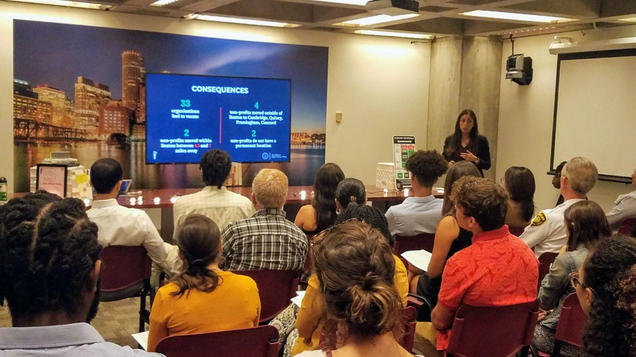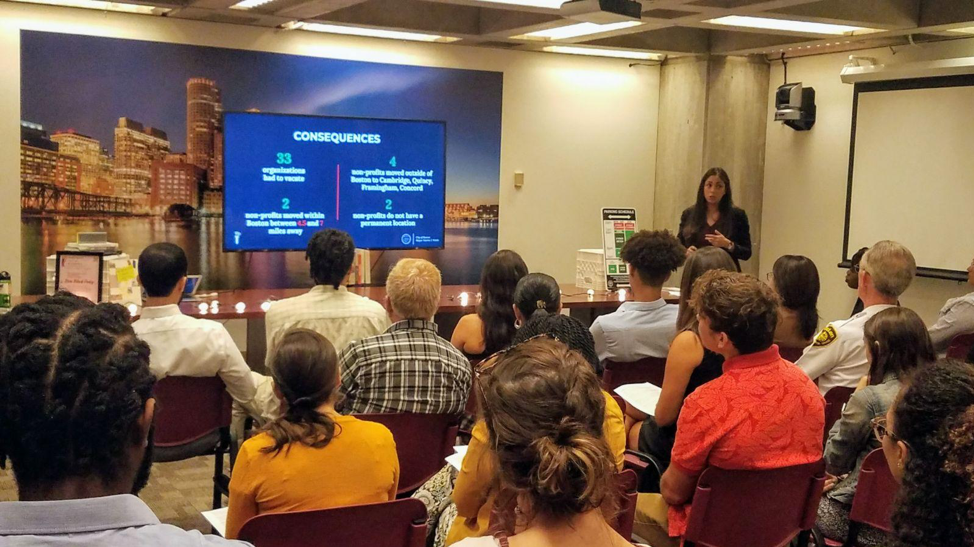Mitigating Displacement for Small Businesses and Nonprofits
By Natalia Chavez

Master’s in Urban Affairs
City of Boston, Mayor’s Office of New Urban Mechanics
Innovation is not usually associated with government. Government has been thought to be uncreative, inefficient, and overly bureaucratic, and in many instances, I’ve seen this to be true. So when I saw there was a summer fellowship at the Boston Mayor’s Office of New Urban Mechanics (MONUM), a civic innovation incubator and R&D Lab within the Boston Mayor’s Office, I was intrigued. To some, this may sound like the Silicon Valley Department within the Mayor’s Office, and in some ways, that might be accurate. But not because MONUM is a technology department, but because they tackle problems in an innovative way. Innovation is more encompassing than technology-driven tinkering or making processes more efficient. Broadly speaking, innovation involves thinking beyond conventional ways to address problems.
To develop innovative solutions to a problem, it is essential to fully understand the problem. A significant part of MONUM’s approach is to delve deeply and gain a better understanding of a problem before exploring possible solutions. This describes my summer project- getting a better understanding of the displacement of small businesses and nonprofits that have been occurring throughout the city. Displacement is often used to refer to residential displacement, but it also affects commercial tenants, such as small businesses and nonprofit organizations, and is disruptive to the operations and services they provide to their communities. During my summer fellowship, I developed case studies of commercial displacement that occurred in two buildings in Boston to better understand the complexity of the problem.
Boston has a hot real estate market, and as a result, rents continue to rise, real estate values increase, and buildings are sold to new owners who renovate them. In many of these situations, tenants are displaced from the buildings where they operated their small businesses and nonprofit organizations. Small businesses “lift up our neighborhoods,” as Mayor Walsh stated in the State of the City address earlier this year. Small businesses contribute to the diversity and vibrancy of a neighborhood and should be celebrated. But with Boston’s real estate market, what can be done to mitigate displacement? What can the City of Boston do to intervene? How does the City implement policies or solutions to support a thriving small business ecosystem?
Displacement, the involuntary relocation of tenants from their current location, has become a main concern as Boston’s rents continue to rise. In an effort to address displacement, the City has developed an anti-displacement approach as part of Imagine Boston 2030, which includes supporting businesses through zoning tools that provide affordable commercial space. However, the majority of the discussion and resources are focused on housing. Imagine Boston 2030 identifies that “the City is developing an anti-displacement approach that combines strategies to increase affordable housing opportunities with policies to reduce residential and commercial eviction, support homeownership, address transportation costs, and facilitate economic well-being.” Commercial displacement is an important part of the anti-displacement approach. Small businesses and nonprofits are often deeply rooted in the community, and when they are displaced, it can have a profound impact on their operations and the neighborhood’s fabric.
Real estate and community development have been areas that have interested me, and this summer project was right up my alley. Tackling commercial displacement was important to the City of Boston and the small businesses and nonprofits that operated within it. But investigating the complexity of commercial displacement within the timespan of my fellowship seemed daunting. Where was I to start?
First, I met with my project sponsor to identify the project’s deliverables and obtain background information that would be useful for the project. I was tasked to develop case studies on the commercial displacement that occurred at two specific buildings in Boston. I then dove into research. Why were the tenants displaced from the buildings I was investigating? Who were the small businesses and nonprofits that were displaced, and where did they go? What was the timeline of the displacement? What were the experiences of the tenants?
I found records of the buildings, including their assessed values over time and the transfer of ownership. I learned that both of the buildings were owned by non-profits who rented their spaces at below-market rents. Both buildings were over 100 years old, and the high maintenance expenses propelled the non-profit owners to sell the buildings. During my research, I came across newspaper articles that shared the stories of the displaced tenants. One tenant had been operating his guitar shop for over 30 years in that building, initially started by his father. Since being evicted, the guitar shop sells its items completely online as the high rents prevented it from relocating to another storefront in Boston.
I contacted the tenants and asked to hear their experience directly and ask some additional questions. One of the individuals I spoke with is the executive director of a nonprofit organization that was displaced from a building located near the Massachusetts Statehouse. The executive director expressed the importance of her nonprofit’s location. They are a social change nonprofit, and the proximity to the Statehouse was crucial as they need to advocate for the individuals they represent. Today, that nonprofit organization is operated from a coworking space since affordable office space has been difficult to find.
Both of the buildings that I was investigating were owned by nonprofit organizations that were unable to afford the maintenance expenses for the historic buildings. They rented their building spaces below market prices, and it’s likely that this contributed to their inability to pay for expensive repairs such as plumbing and window replacements. I recommended that the City look into assisting building owners, especially nonprofit building owners, with financing maintenance expenses.
There are limited City resources to help nonprofits. Unlike small businesses, nonprofit organizations do not have an allocated City department that works with them. The Small Business Development works with many small businesses; however, they often struggle to collaborate with nonprofit organizations due to limited funding allocations. The City could consider additional interventions to mitigate the negative impacts of commercial displacement, including assistance with relocation expenses and finding new spaces for displaced tenants. Additionally, the City could encourage tenants to obtain leases and repurpose or acquire buildings for small businesses and nonprofits.
I presented my findings to a room full of city staff, and I believe my research will help inform the implementation of policies and solutions to support a thriving small business and nonprofit ecosystem. And in true MONUM form, I approached this difficult problem by opening doors to all the possibilities. I approached this complex problem by not thinking about what is plausible, but rather what is possible.
 Image: Natalia presenting her findings to city staff
Image: Natalia presenting her findings to city staff
